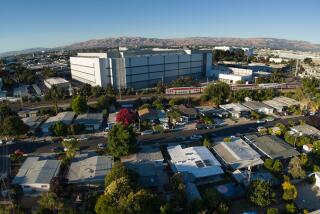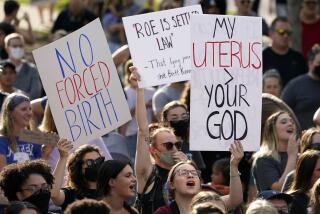Column: Iowa’s handout to Apple illustrates the folly of corporate welfare deals
- Share via
State and local officials in Iowa have been working hard to rationalize their handout of more than $208 million in tax benefits to Apple, one of the world’s richest companies, for a data facility that will host 50 permanent jobs.
The deal will help make Iowa an “innovation and technology” hub, Gov. Kim Reynolds gushed. It will ensure development of a big parcel of open land that otherwise would have remained fallow, local development officials said. It was a bargain, according to civic leaders in Waukee, the Iowa community that will host the data center — after all, Apple will be contributing up to $100 million to a local infrastructure fund, starting with money to build a youth sports center.
We were highly skeptical of this deal when it was announced Aug. 24. In the fullness of time, we’ve subjected it to closer scrutiny. And now it looks even worse.
There is virtually no association between economic development incentives and any measure of economic performance.
— Economist Richard Florida
In a broader sense, the Apple deal shows the shortcomings of all such corporate handouts, nationwide. State and local governments seldom perform cost-benefit studies to determine their value — except in retrospect, when the money already has been paid out. They seldom explain why some industries should be favored over others — think about the film production incentives offered by Michigan, Louisiana, Georgia and, yes, Iowa, which never panned out as profit-makers for the states. They’re often negotiated in secret, as was the Iowa deal, then presented to taxpayers as faits accomplis — and often misleadingly.
These incentives often are an unnecessary bonus to companies that already have made a site location decision based on more important factors. Yet states and localities have persuaded themselves that the incentive packages are an indispensable lure to employers and that without them their economies will collapse.
“Firms know where they want to be,” says economist David Swenson of Iowa State University. “The question of how much in rents they can extract from state and local governments is phase two. But taxes are a secondary consideration.”
Worst of all, the handouts allow big companies to pit state against state and city against city in a competition that benefits corporate shareholders almost exclusively. Bizarrely, this process has been explicitly endorsed by Donald Trump. Companies “can leave from state to state and they can negotiate good deals with the different states and all of that,” Trump said in December, as long as they’re not taking the jobs across the border. This is a formula, of course, for what some might compare to unrestrained corporate extortion.
These corporate handouts might make sense if they spurred economic growth. They don’t.
“There is virtually no association between economic development incentives and any measure of economic performance,” urban economist Richard Florida concluded in 2012. A study of his found “no statistically significant association between economic development incentives per capita and average wages or incomes; none between incentives and college grads or knowledge workers; and none between incentives and the state unemployment rate.”
Another study found that, if anything, government incentives led to slower growth among the companies that received them, possibly because their managers spent more time pursuing incentives than focusing on the business, and felt less pressure to seek out nonincentive-related growth opportunities.
Apple’s deal with Iowa, which includes about $20 million in a state investment tax credit and a 20-year tax abatement from the city of Waukee worth nearly $190 million, underscores all these elements. First, it was put together behind closed doors and presented to state legislators and economic officials only after the fact. Some elements of the package are still shrouded in mystery.
But at least one major element of the original announcement has proven to be extremely misleading. That’s Apple’s contribution of “up to $100 million” to an infrastructure fund for Waukee. As it turns out, “up to” was an important but overlooked phrase. That’s because the total contribution would be dependent on expansion of the data center well beyond the 400,000 square feet originally announced. Unless that expansion occurs, Apple’s contribution will be only $20 million, a source close to the deal told me. In other words, Apple is guaranteed to contribute only one-fifth as much as people were led to believe.
Apple has sound reasons for locating a $1.3-billion data center — which will provide a technical background to services such as its Siri voice-activated assistance service, iTunes and its App Store — on the Iowa prairie. Iowa has abundant wind generation, which enables the company to say the center will operate on electricity from 100% renewable sources. It has plenty of good, flat land if the company decides to expand its data warehouse. And it’s relatively well-insulated from weather extremes, not to mention coastal weather disasters.
As it happens, Apple was already eligible for a major tax break even before it entered negotiations for this deal. In 2007, the legislature enacted a sales tax exemption specifically for data centers, covering their servers, industrial coolers, backup generators, and other computer equipment. Since Apple is planning to spend about $645 million on equipment for the data center, according to Reuters, that implies a break of nearly $39 million from the state’s 6% sales and use tax. Because the exemption was preexisting, it wasn’t even mentioned during the gala announcement of how much Apple would be getting to move to Iowa.
Justifying public outlays of this magnitude, one must have a handle on their possible contribution to employment. In the case of data centers, Swenson argues, it’s meager. Not only is the permanent direct employment forecast for the Apple facility a mere 50 people, the potential for indirect employment is also small. Microsoft and Google data centers preceded Apple to Iowa, Swenson observes. “These centers have absolutely no linkages upstream or downstream with the rest of the economy, except for the upstream grab of electricity,” he says. “They’re just big, sterile, hot boxes that don’t feed into Iowa’s economy.”
Indeed, even as Iowa’s data-center complex has expanded over the years, its employment in the sector has shrunk, possibly because the centers are increasingly automated. According to data from the Bureau of Labor Statistics, Iowa employment in the “data processing, hosting, and related services” sector has been falling sharply, to about 3,400 last year from more than 7,400 in 2007. The state’s share of all such employment nationally also has fallen to about 1% now from nearly 3% in 2007. The lesson is that if Iowa officials think their handouts will place them at the hub of a high-tech revolution, they’re chasing an imaginary grail.
Yet politicians continue to shovel out the benefits, hoping to steer their economies in new directions and perhaps acquire a reputation for vision. Nevada was so eager to land a big battery factory from Tesla Motors’ Elon Musk that it offered him twice what Musk was seeking from the five states competing for the project. (In Las Vegas, this is known as “leaving money on the table.”) Wisconsin Gov. Scott Walker gave a big incentive deal to a furniture factory even though it was laying off half its workforce. He followed up last month with an astronomical $3-billion handout to electronics manufacturer Foxconn for a factory likely to employ a fraction of the workforce it forecasts.
The biggest scam of all may be film incentives, which peaked a few years ago when states across the country began to see themselves as rivals to California. The pioneer in this effort, Louisiana, was later shown to be spending $7.29 in incentives for every dollar in revenue brought in. (“People are getting rich on this deal, and it’s not Louisiana taxpayers,” concluded the study’s sponsor, the Louisiana Budget Project.) California eventually was forced to counter the proliferating production raids with a program of its own, but even its relatively modest package costs $1 in outlay for every 65 cents returned to the treasury. Iowa’s film incentive program, by the way, was such a mess that it collapsed in 2009 amid scandal, leading to several felony convictions.
This is how states and localities end up on a merry-go-round of infinite spending. Whenever another deal gets proposed by starry-eyed politicians, the taxpayers should just say no.
Keep up to date with Michael Hiltzik. Follow @hiltzikm on Twitter, see his Facebook page, or email [email protected].
Return to Michael Hiltzik’s blog.
MORE FROM MICHAEL HILTZIK
Memo to economists defending price gouging in a disaster: It’s still wrong, morally and economically
“I-M-P-E-A-C-H”: People quitting Trump are now doing so in code







